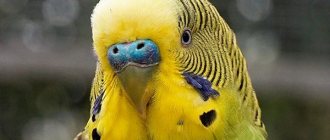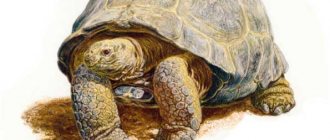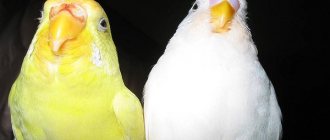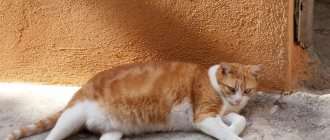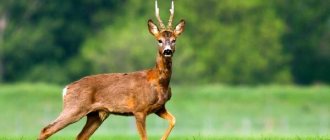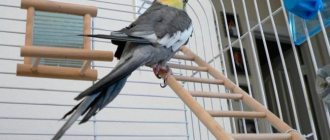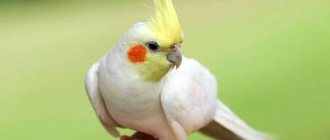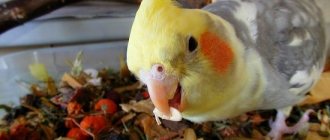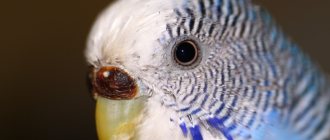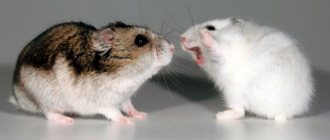The Corella parrot breeds easily in captivity, and this suits breeders. Professional breeders, through many years of selection, have managed to breed many subspecies of these beautiful birds. Artificial breeding has so affected the color of the plumage that all sexual characteristics are mixed up. Now it can be difficult to recognize whether the cockatiel is a boy or a girl.
Methods for determining the sex of a cockatiel
Corellas do not have clearly defined sexual characteristics, so even an experienced breeder does not always understand who is in front of him: a female or a male. In most cases, people buy birds in pet stores and markets, where sellers are interested in a quick sale. They don't need to understand the sexual dimorphism of parrots. In order to sell live goods from your hands, they will confirm to you what you want to hear.
Let's say you take home a bird for the first time. It’s okay if the purchased chick turns out to be the wrong sex: starting to get acquainted with parrots is interesting in any case. But when you purposefully follow a boy or girl, theoretical knowledge will not hurt. At an early age, you can determine the sex of a cockatiel based on three methods:
- Appearance and behavior. The characteristic features of males and females appear only after the first moult; before that, they are colored the same, and their habits are almost the same. Of course, no one forbids making assumptions, but obvious differences will arise once the parrot reaches puberty.
- Laboratory DNA analysis. Gives a high probability of determining gender.
- Genetics. The accuracy of the method is from 50 to 100%. The difficulty is that to find out the sex of the chick you need to see its parents. When purchasing from a store rather than from a breeder, there is no guarantee of the right choice. There is no need to go into detail about the structure of chromosomes; you can simply compare the parrot with mom and dad.
If you are breeding cockatiels, take a closer look at the growing chicks, note the signs inherent in one or the other sex. Boys begin to sing at about three months, so it doesn’t hurt to mark the paw of the supposed male with a ring. This will help guide you in the future when selling birds, because during molting all differences between male and female birds disappear.
Care
Keeping an eye on Cockatiels at home is not as easy as it seems. First of all, to keep parrots, you need to buy a cage. It must be roomy so that the parrot can move freely around the house from anywhere. The smallest cell parameters correspond to 65 centimeters in height and 50 centimeters in width. The perimeter is approximately no less than one meter.
Choose a house made of pure stainless material. To make cleaning easier, the bottom should be spread over the pull-out tray. Place two or three wooden posts inside the cage, but do not place them above the feeders. If branches from the yard are being used as posts, be sure to run boiling water over them to maintain sanitation.
Caring for cockatiels will require daily cleaning of the tray. It is also necessary to carry out general cleaning once a week: thoroughly wash the cage and everything in it. Place it in a bright room at eye level so that the pet will soon get used to family members. Do not place in drafts or direct sunlight, especially during hot weather suitable for your area.
Appearance
It is a little easier to determine the sex of a cockatiel that is more than a year old, because by this time the bird has acquired new feathers and matured physically. In the appearance of an adult parrot, features appear that indicate belonging to a specific gender:
- in the male the tail is wedge-shaped, pointed, in the female it is in the form of a blade;
- the structure of the female’s pelvic bones does not allow her to place her paws close, she sits low and walks like a duck;
- The boy has a curved narrow crest, wide at the base, the girl has a more magnificent and straight crest;
- the female is large and heavy, the body shape is round;
- Regardless of the subspecies, the male is brighter and more attractive than the female.
This method of sex recognition can be called relatively truthful, since two birds of different sexes are compared to identify gender differences. If you have one parrot, you can only judge its gender based on its appearance only conditionally.
There is no point in asking experts on forums or sending photos of cockatiels to breeders. A frozen image of a bird will not tell you anything; it is impossible to determine the gender with its help.
Reproduction and breeding
Nature creates the entire environment for the life of the inhabitants of the planet Corellas. Therefore, each male is given the opportunity to feed and reproduce without obstacles. Such conditions occur during the rainy season, when food supply increases for all members of the bird group.
The nest, which is located in hollow branches and trunks of already withered trees, contains approximately 3 to 7 Corella eggs, preferably whitish-colored shells. They incubate the eggs for 3 weeks (21 days), in which neither one, but both parents participate. Chicks are born with yellow fluff. Getting ready to release the cubs after a month or a month and a half, the parents begin to hatch the next offspring.
In a family setting, breeding nymph parrots is not easy, but feasible. It is not enough to prepare the entire external environment; you need to set the birds up for a close relationship and choice of partners, without aggression (for beginners, this means combining the cage and observing behavior). After this, you can see the stage of pregnancy and how the female parrot laid a clutch of eggs. How many eggs there will be depends on favorable conditions.
Please note that, for example, lutino parrots love to fly to maintain a healthy shape. Therefore, free him from his house so that the bird can fly. If it is not possible to release it, a large cage is purchased so that the bird can fly right in it. When releasing the parrot, do not forget to close the windows, and at this hour it is also worth prohibiting access to dogs and cats.
Characteristic behavior
Breeders note that adult males and females are strikingly different from each other in habits. This is what boys do:
- they sing loudly, especially when the reproductive instinct awakens;
- tap dance with their beaks on ringing surfaces;
- protrude the wings and fold them in the shape of a heart;
- walk freely towards a person, are not afraid of hands;
- they put their paw on their cage neighbor, showing the character of a conqueror.
Corella girls do not strive to amaze others with their talents. They are phlegmatic, modest, quiet. They don't sing, they coo. They don’t allow you to pull yourself together, they swear and bite. They are constantly busy organizing their home. During mating games, the female accepts courtship, and the male displays himself and shows himself in all his glory.
A bird living alone suddenly laid an egg - this is a female, now there can be no mistake. This is one of two cases when you can find out the sex of a cockatiel with 100% accuracy.
What to name a boy's parrot?
for boys - Arkasha, Arsyusha, Gavryusha, Gesha, Grisha, Gosha, Dyusha, Karpusha, Kesha, Kiryusha, Petrusha, Prosha, Tisha, Tosha, Toshik, Yasha; for girls - Agasha, Arisha, Varyusha, Glasha, Dasha, Karkusha, Stesha, Tesha, Sherry, Shusha, Chika.
Interesting materials:
When does the summer sale at Zara start? When does Muharram 2022 start? When does the new moon begin? When does the new decade start? When does old age begin? When does the college session start? When does a free throw start in basketball? When does conscript service begin? When does cherry blossom start? When does sap flow begin in trees?
DNA analysis
The second case that gives confidence that a bird belongs to one sex or another is DNA analysis. The effectiveness of using this method has long been proven, but its cost is too high. In addition, laboratories engaged in such analyzes are located only in large cities. You need to have a good reason to try to determine the sex of a cockatiel using DNA.
The laboratory takes feathers, blood or sewage from the cloaca for analysis. Identification of newborn chicks is possible by the shell with membrane from which they hatched. If feathers are chosen as the object of study, they need to be specially plucked - those that fall out on their own are not suitable. The down under the wing is not informative; medium feathers with a white tip are taken. At the end of the work, the laboratory technician sends the result by email or notifies you by phone.
The selected material must be submitted for verification within two days.
Intelligence and character
All types of cockatiels are recognizable due to their unpretentious and friendly personality. Birds get along easily with humans and are smart conversationalists. It is not their behavior to be aggressive towards people or their own kind. They quickly learn individual words and phrases and are able to remember melodies (the opposite of a lovebird).
The optimal vocabulary of a cockatiel is 200-300 words. Like any animals and birds, cockatiels can be trained using the gingerbread method. They reproduce with detailed accuracy the sounds of household noise, such as opening a door, a doorbell, or a telephone. In this they are similar to their closest cousins, the cockatoo, the rosella or the Indian necklace.
In order to teach a Corella to speak, you need to buy a chick in childhood and it is best that it is immediately accustomed to being handled. They remember well the sounds with which they associate a certain room, time or action. If you tell your pet a story, the cockatiel will forget it the next day.
For example, the phrase “Good morning” is said only before feeding. If you repeat it repeatedly throughout the day, she will simply say it mindlessly. For every attempt, even if it’s not clear, reward him with a treat or a pat on the neck.
The Corella parrot remembers its name faster with the accompaniment of voicing actions (Kuku eats, Kukku goes to bed, etc.). Parrots are very affectionate towards their owners and treat them as members of the flock. Males, as a rule, are more active than females, whistle and their chirps are more melodious. Breeding requires extreme caution and attentiveness on the part of the owners. If the very nature of pets is kind to humans, this does not mean docile behavior when there are a large number of birds in a confined space.
Plumage color
As they grow older, all parrots go through a juvenile molt - a radical change in plumage. The inconspicuous baby fluff sheds, and is replaced by dense, richly colored feathers. In cockatiels, this occurs between 8 and 12 months. Usually, by the second year of life, a bird acquires the feather color that was genetically determined by its parents. It is much easier to distinguish a male from a female if they have a dominant gray color, but with some mutations this is almost impossible to do by appearance.
Natural gray
The natural cockatiel is called dimorphic, which means there is a clear difference between birds of opposite sexes. Natural coloring makes it easy to determine the sex of a cockatiel parrot. The boys' body is covered with gray feathers, on the head there is a yellow mask and a crest. Round orange spots “bloom” on the cheeks.
The girls are a little lighter, their feathers seem to be sprinkled with dust. The gray mask is slightly diluted with yellow, the crest is brown. The cheeks of a young female are light yellow, and with age they acquire a brick tint. The tail feathers are slightly yellowed along the edges and marked with horizontal black stripes along their entire length. Light spots are barely noticeable on the inside of the wings.
White-faced cheekless
These birds have different colors, with the exception of lutino. They do not have yellow pigment. A clear peculiar feature is the absence of orange circles on the cheeks. The mask on the head of the male is pure white; in females there is an admixture of gray or cinnamon shades.
Lyutino
Bright color, artificially bred. The mutation gene suppresses natural coloring, resulting in yellow parrots mixed with white. Red-eyed males are identical in appearance to females, making it extremely difficult to determine their gender. If you're lucky, you'll find dark streaks on the bird's tail and dots on the wings, like natural cockatiels. This means that this is a female.
Pearl barley
Corellas, whose coloring is called “pearl,” look very impressive: their feathers have a special pearl-shaped pattern. The center of the feather is white or yellow, and the edges are darkened. The first molt deprives the male of all his beauty, or it happens after a while, but the female remains beautiful for her entire life.
Albino
Albino males and females are white, their mask and forelock are yellow. The cheek spots are the same, the eyes are red. A minor difference with the female is that her wings and tail appear to have been sprayed with pale yellow paint.
White
A very expressive mutation, it appears from crossing gray males with albino females. The result of selection is white cockatiels with a sunny yellow tint of feathers. The eyes of such majestic individuals are usually black. How to recognize a white male? The tail feathers on his tail are white, without any impurities.
Determination methods
The poultry hobbyist should only buy young birds if he wants to:
- He managed to successfully tame the parrot.
- His pet learned to speak well.
- The purchased bird lived for a long time.
This is where many novice amateurs make mistakes. They are associated both with direct deception on the part of sellers who sell an old parrot under the guise of a young one, and with the mistakes of the buyer who does not know how to correctly determine the age of the bird. Often even novice sellers do not know how to do this. It also happens that a seller who has a lot of poultry products gets confused and sells an already mature bird as a young one.
There is only one way out of the situation - to determine the age of the cockatiel parrot immediately before purchasing. This can be done based on a number of external signs. The color of young and old birds differs little, so you need to look very carefully. The practical experience of many generations of poultry farmers suggests a number of ways to determine the age of cockatiels. All of them take into account the differences between a young parrot and an old one in small details.
On the head
This part of the body contains organs, by the appearance of which one can try to determine the approximate age of the bird being examined. These are the eyes, beak and crest.
By the eyes
How to find out the age of a cockatiel parrot by its eyes? You need to take a close look at their color. The eyes of young parrots shine, their color has a brownish tint. Their irises are black. Adult parrots have dull eyes. As the bird gets older, they gradually darken and eventually turn black. The iris of adults is brown. As life goes on, it becomes more and more clear.
By the crest
When buying a new bird, you should pay close attention to the condition of the plumage of its head. The head of a young cockatiel has the following characteristic features:
- The feathers on the crest are short and straight.
- There are small tubes on the skin from which new feathers will then appear.
If the bird is already mature, then the ends of the feathers of its crest are slightly curved. There may be an open area of skin under the tuft.
By beak color
Another marker is the color of the parrot's beak. In chicks it is pale pink, with a light wax. In adult birds it becomes dark gray over time. In addition, the beak of adult parrots is much larger.
By paws and claws
You can determine the approximate age of a cockatiel by paying close attention to its paws and claws. The claws of young birds are small, with a pinkish tint. With age, the claws grow and become darker, acquiring a grayish tint during the life of the bird.
The chicks' feet are pinkish. There are no cracks on their surface. The feet of six-month-old birds are darker, with pronounced horny scales and cracks on their surface.
By plumage
You can determine approximately how long a bird has lived by the state of its plumage. It is completely different for chicks and mature cockatiels.
The chicks have not yet gained life experience and do not know how to care for their feathers at all. They are disheveled, there may be bird droppings on them, which young birds do not yet know how to clean off. A short tail and dull feather color also indicate that the parrots are barely fledged.
In adult parrots, the plumage looks much more beautiful. It is quite brightly colored. It is well-groomed, as the birds love and know how to clean it. The tail of adult cockatiels is much longer than that of juveniles.
At about 4 months of age, the chicks begin to molt. They develop beautiful plumage at the age of about 6 months. Therefore, molting is one of the signs of an individual’s youth. But adults can also shed if they suffer from infectious diseases.
By singing
Young birds cannot sing. They master this task by about the age of 6 months. Adult parrots sing very beautifully. Therefore, if a bird sings well enough, it means it is no longer a chick.
By behavior
The behavior and movements of young birds differ from those of adult birds. Young parrots fly poorly or do not yet know how to do it at all. They sleep, leaning on a perch with two paws, or even sitting on the bars of the cage. It is still difficult for them to maintain balance. Very old cockatiels can sleep in the same position, and a potential parrot buyer should remember this. Adult pets usually sleep leaning on a perch with only one paw.
Are you sure you need this breed?
Before we start talking about how to distinguish a boy from a girl Corella, you should understand whether it is worth purchasing one. Before buying a pet, you should prepare everything necessary for the bird’s normal existence in the apartment:
Corella needs a cage and toys to live comfortably in your apartment.
First of all, you need to understand whether the owner can devote a lot of time to raising and spending time with the bird. Cockatiels love to communicate and do not want to be alone with themselves. On top of everything else, they constantly litter not only in the cage, but also around it. The cost of the bird is not very high, and it can be afforded by the average family. But then get ready to spend. If a new resident is alone in the house every day for a long time, then he will not live long.
What else? At any age, they love to make a lot of noise, sing and play around. They prefer free flights around the living space, which causes damage to wallpaper, doors and furniture. In this case, birds can be pinched. Accuracy and plenty of time for normal care are the main things that a person buying this type should accept and understand.
What to do if you don’t want to let your pet roam around the house? Buy a large cage, the height of which will be at least 60 cm. It is best if the walls look like a cage, and not simple vertical teeth. This way he will have something to do while the owner is not at home: smoothly climb from twig to twig. Clings perfectly. But if the rods are only vertical, then the tenacious paws will not be able to hold on. Lots of perches and full equipment for an entertainment program:
Only under such conditions will it be possible to avoid boredom, but not for long. The trash bin that the bird leaves behind will have to be cleaned up daily. You won't need to spend a lot of time on this if you put the paper on the bottom of the cage.
